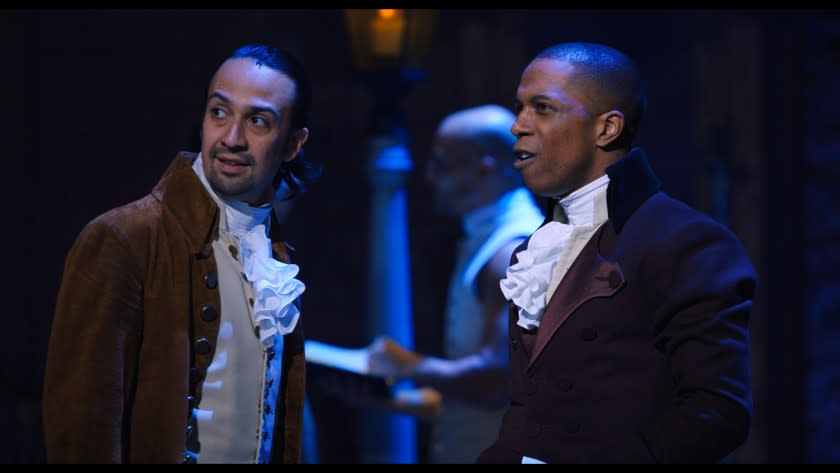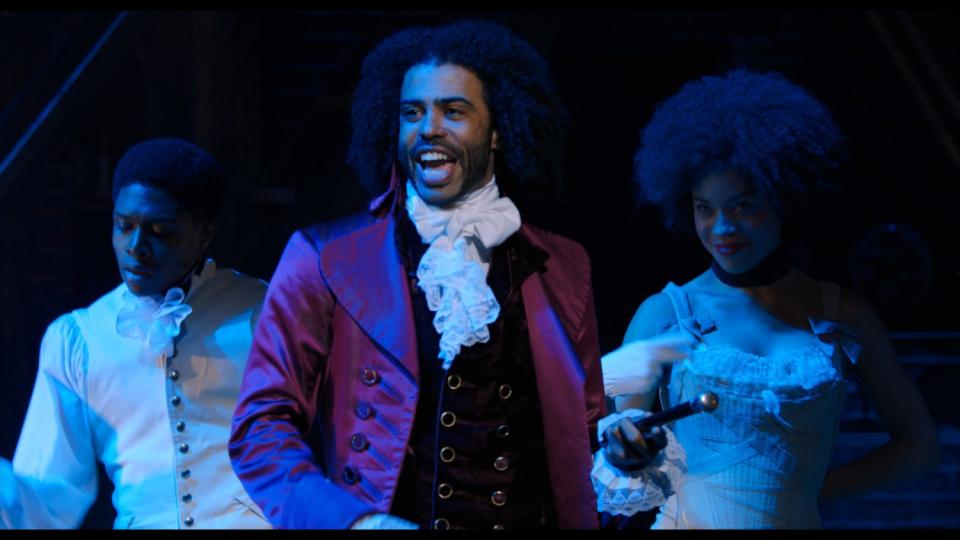Review: From Broadway to Disney+, 'Hamilton' speaks brilliantly to a time of fear and protest

As the Revolutionary War nears its climax in “Hamilton,” Lin-Manuel Miranda’s great American barnstormer of a musical, Gen. George Washington orders a hotheaded young aide to return home and cool his heels. Fiercely ambitious and eager to command troops of his own, Alexander Hamilton — still years from becoming the first Treasury secretary or co-authoring the Federalist Papers — is disappointed by this forced respite from duty. It falls to his wife, Elizabeth, who is pregnant with their first child, to offer some clarity and perspective in song: “Look around, look around at how lucky we are to be alive right now.”
Of all the dazzlingly articulated sentiments in “Hamilton,” few may sound more incongruous right now than that one — or, paradoxically, more fitting. To be a living, thinking American in 2020, during a health crisis that has claimed thousands of lives and may claim many more, is to experience a strange commingling of relief, horror and guilt. To see a nation protesting (again) the destruction and oppression of Black lives is to be flooded with disorienting bursts of despair and hope. We live in a contradictory moment, and “Hamilton” — a joyous synthesis of popular culture and people’s history, a utopian vision of equality set in profoundly unequal times — is nothing if not animated by its own contradictions.
That remains entirely apparent in this straightforward, stirring visual record of the original Broadway production, which was filmed over two June 2016 performances directed (for stage and screen) by the multitasking Thomas Kail. For those of us who have never seen the stage show, and have compensated by spending many happy hours with the soundtrack, it’s a particular pleasure to be figuratively ushered into the live Richard Rodgers Theatre audience, whose applause you often hear and whose presence you sometimes glimpse in passing. Unaltered from that initial staging, apart from some seamless editing (by Jonah Moran) and the silencing of a few family-unfriendly expletives, this filmed “Hamilton” is somehow both a four-year-old time capsule and a timely encounter with the present.
Disney, which acquired the film earlier this year, had originally planned an October 2021 theatrical release. But when theaters closed due to the COVID-19 pandemic, it decided to make “Hamilton” available for streaming on Disney+ more than a year early — just in time for a July 4 holiday under quarantine and, less expectedly, for our latest convulsive nationwide referendum on systemic racism and authoritarian violence. It’s hard to imagine a more receptive backdrop for a drama that ingeniously recasts the Founding Fathers as people of color, placing America's oft-repeated "nation of immigrants" rhetoric into the most literal terms imaginable. Nor can I think of a better moment for a musical that reminds us anew that the language of hip-hop is a language of protest.

None of which is meant to suggest that this is “the film we need right now” or to burden “Hamilton” with messianic claims that the show — a celebration of a once-unsung hero and a pointed reminder of the limitations of heroism — would never make for itself. Reviewing the touring production at the Hollywood Pantages Theatre in 2017, my Times colleague Charles McNulty noted that "its embodiment of pluralism and diversity will touch anyone who longs to see America live up to its ideals," and the same holds true of this filmed version. Miranda’s rap-sodic historical epic may not save the soul of a battered republic, but its consolations are real, its pleasures revivifying, its emotional force galvanic. Arriving at a moment of intensifying darkness, it shines a light that is both warm and persistent.
This is a work that understands the improbability of its own existence and success — and assuredly shrugs it off, much as the low-born, high-minded Hamilton must have had to do at some point. The entire story is framed as an answer to the question slyly posed at the outset: “How does a bastard, orphan, son of a whore and a / Scotsman, dropped in the middle of a forgotten / spot in the Caribbean by providence, impoverished, in squalor, / grow up to be a hero and a scholar?”
Those are the words of Aaron Burr (the splendid Leslie Odom Jr., winner of one of the show’s 11 Tony Awards), the coolly calculating politico and future vice president who will emerge as Hamilton’s chief rival and fire the fatal shot in their famous duel. But not, of course, until after he spends years bearing frustrated witness to Hamilton’s prodigious rise from poverty and illegitimacy to achieve lasting fame and influence as a military strategist, constitutional defender and economic mastermind.
Even in this chronicle of a death foretold, that journey never feels like a foregone conclusion, due in no small part to the modulated intensity and often-exquisite delicacy of Miranda’s performance in the title role. His delivery is as expressive as it is virtuosic; his lyrics become a poetic analog for Hamilton’s own strengths and weaknesses — his emotional earnestness, political transparency and formidable, sometimes insufferable intellect. Miranda’s book and lyrics (inspired by Ron Chernow’s 2004 Hamilton biography) may elide the finer complexities of the banking system, but you recognize instinctively, in those syncopated verbal rhythms and coruscating rhymes, the internal circuitry of a gifted writer’s mind.

Those gifts are happily doled out across the entirety of this sprawling and pointedly egalitarian production. David Korins' spare maritime set, versatile enough to evoke Hamilton’s St. Croix childhood as well as the war-ravaged harbors of Boston and New York, is soon bustling with rivals, allies and admirers, played by predominantly Black and Latino actors dressed in 18th century finery. We see Hamilton carousing with friends like the Marquis de Lafayette (the sensational Daveed Diggs), John Laurens (Anthony Ramos) and Hercules Mulligan (Okieriete Onaodowan), drinking and sparring and plotting their response (“Rise up!”) to the ever-wearying millstone of British rule. We also see him and Burr make competitive strides into society life, where Hamilton wins the heart and hand of the wealthy Elizabeth Schuyler (Phillipa Soo), even though her sharp-witted older sister, Angelica (Renée Elise Goldsberry), is in many ways his truer match.
It’s no knock to observe that the camera coverage is mostly fluid and functional, given the tight timing of the shoot, the size of the ensemble and the fact that the play really is the thing here. Declan Quinn’s photography complements rather than obscures Kail’s stagecraft, and allows you to enjoy the dynamism of Howell Binkley’s lighting and of Andy Blankenbuehler’s frame-spilling choreography. Nine cameras were installed around the theater for these performances, and at no point — not even with the occasional God’s-eye flourish — does any of them seem to be in the wrong place.
Due to the abundance of long shots and smooth cutting, the intermittent closeups are all the more striking in their intimacy. And sometimes their comedy, as whenever King George III (the wonderfully imperious Jonathan Groff) checks in to roll his eyes at the progress of the American Revolution and, after England’s defeat, the messiness and grandeur of the American experiment. Act 2 finds Hamilton and his associates scaling new heights of influence and opportunity, including the opportunity for heartache. There are the joys and tragedies of parenthood, as well as the temptations of an affair with the married Maria Reynolds (Jasmine Cephas Jones), placing Hamilton at the center of the nation’s first political sex scandal.
Most satisfyingly, there are the furious Cabinet jousts over the merits of Hamilton’s proposed banking system and the agrarian ideologies of his other major nemesis, Thomas Jefferson (Diggs again, one of several actors who played dual roles on Broadway). You are reminded that the art of statecraft remains fertile, under-tilled dramatic territory, even if real-life policymaking rarely makes room for insults as delightful as “Would you like to join us, or stay mellow / Doin’ whatever the hell it is you do in Monticello.” And through it all, the music — both the magnificence of the actors’ singing and the infectious loveliness of Alex Lacamoire’s orchestrations — acts as a sustaining force, ironing out brief lapses in the storytelling and lending this 161-minute work its furious momentum.

One tendency of so much biographical fiction, whether on page, stage or screen, is to flatter and flatten the lives of major historical figures. That tendency is held in check here by the recurring perspective of Odom's Burr, whose calculating, close-to-the-vest approach proves both the equal and the antithesis of Hamilton’s own heart-on-his-sleeve ambition. Burr is harder to warm to but perhaps easier to pity, depending on whether you see him as more of an Iago or a Salieri. Those reference points are hardly accidental: “Hamilton” draws lyrical, narrative and stylistic energy from every direction, from Rodgers and Hammerstein to Gilbert and Sullivan, from the Notorious B.I.G. to Destiny’s Child to Shakespeare.
This delirious style of cultural-historical fusion is meant to leave you with as many questions as answers, and “Hamilton,” like any breathless phenomenon, has not gone unchallenged. Historians have unsurprisingly taken the show to task for its inaccuracies, and also for perpetuating the dubious aesthetics of “Founders Chic.” Some see in Miranda’s work an uncritical glorification of a Wall Street forerunner; others see a story that is considerably more progressive on race than gender. And speaking of race, perhaps the most trenchant criticism has been that “Hamilton” glosses over its hero’s ambivalent position on slavery, adding a note of dissonance, less fatal than fascinating, to the racially inclusive casting that remains its most significant masterstroke.
As I said: contradictions. And contradictions, which lie at the heart of democracy itself, are nothing to be feared. Really, they are only likely to deepen as this film turns living rooms into makeshift cinemas and auditoriums, igniting fresh admiration and dissent along the way. How could it do otherwise? It’s worth remembering that “Hamilton,” the consummate theatrical work of the Obama years, also claimed one of the earliest cultural skirmishes of the Trump era, when Vice President-elect Mike Pence attended the show in November 2016 and was personally called out from the stage. Four years later, it’s hard not to feel that “Hamilton” has never really gone away (and not only because a former national security advisor just published a controversial memoir whose title riffs on one of Miranda’s best songs, “The Room Where It Happens”).
Such confrontations are only to be expected from a work that not only engages with history but, through its reach and renown, becomes a part of it. One of the show’s more obvious lessons is that history is a living, breathing entity, and that the cyclical rise-and-fall narratives of leaders and empires can be studied and recounted in ways that uncover bold new patterns of meaning. This film, a solid capture of a momentous work of art, illuminates those patterns in ways both sobering and thrilling. I still hesitate to call “Hamilton” the film we need right now, partly because it deserves better than boilerplate hype. And partly because I suspect that, as with all reverberant history, its most significant work may still be ahead of it.

